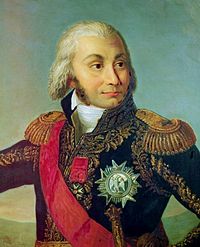| Army of the Danube | |
|---|---|
 Jean-Baptiste Jourdan, initial commander-in-chief of the Army of the Danube | |
| Active | 2 March – 11 December 1799 |
| Disbanded | 24 November 1799–11 December 1799 units merged into Army of the Rhine; Army remained on paper until 11 December 1799, when its commander was reassigned.[1] |
| Country | |
| Type | Field Army |
| Role | Invasion of southwestern Germany |
| Size | approximately 25,000 |
| Engagements | Battle of Ostrach (without Vandamme's detached flank) Battle of Stockach (1799) Battle of Winterthur (Most of Advance Guard, plus elements of I. Division and part of Reserves) First Battle of Zürich (Advance Guard and elements of I. Division) Second Battle of Zürich (Advance Guard, elements of I. and III. Divisions and Reserve) |
| Commanders | |
| Notable commanders | Jean-Baptiste Jourdan André Masséna Louis Marie Turreau |
The Army of the Danube was a field army of the French First Republic. Originally named the Army of Observation, it was expanded with elements of the Army of Mainz (Mayence) and the Army of Helvetia (Switzerland). The army had three divisions plus an advance guard, a reserve, and an artillery park.[2] The artillery park was under the command of Jean Ambroise Baston de Lariboisière and consisted of 33 cannons and 19 howitzers operated by 1,329 non-commissioned officers and cannoneers as well as 60 officers. There were approximately 25,000 members of the Army, the role of which was to invade southwestern Germany, precipitating the War of the Second Coalition.
The Army crossed the Rhine River on 1 March 1799 under the command of Jean-Baptiste Jourdan, in the order of battle below. As elements crossed the Rhine, they took the name "Army of the Danube". The crossing was completed by 7 March.[2] After passing through the Black Forest, the Army fought two battles in quick succession, the Battle of Ostrach, on 20–21 March, and Stockach, on 25–26 March. It suffered badly in both engagements and, following the action at Stockach, withdrew to the Black Forest. Jourdan established his headquarters at Hornberg, and the Reserve cavalry and the cavalry of the Advance Guard quartered near Offenburg, where the horses could find better forage.[3]
Initially, the Army included six future Marshals of France: its commander-in-chief, Jourdan; François Joseph Lefebvre; Jean-Baptiste Drouet; Laurent de Gouvion Saint-Cyr; Gabriel Jean Joseph Molitor; and Édouard Adolphe Casimir Joseph Mortier.[4] After the defeat at Ostrach, the Army was reorganized and command shifted to another future marshal, André Masséna.[5] Under Masséna's command, elements of the army participated in skirmishes in Switzerland, the eleven-hour Battle of Winterthur and the First and Second Battles of Zürich.[6] The Army was disbanded in November 1799 and its units dispersed among other French field armies by mid-December.[1]
- ^ a b Adolphe Thiers. The History of the French Revolution. New York: Appleton, 1854, v. 4., pp. 370, 401–402; Smith, "Clash at Winterthur." Databook, pp. 156–157.
- ^ a b Jean-Baptiste Jourdan. A Memoir of the Operations of the Army of the Danube under the Command of General Jourdan, Taken from the Manuscripts of that Officer. London: Debrett, 1799, p. 140.
- ^ Digby Smith. Napoleonic Wars Databook: Actions and Losses in Personnel, Colours, Standards and Artillery, 1792–1815. Mechanicsburg PA: Stackpole, 1998, ISBN 1-85367-276-9, pp. 147–148.
- ^ Smith, Databook, p. 150.
- ^ Smith, "Clash at Winterthur." Databook, p. 156–157.
- ^ Lina Hug and Richard Stead. Switzerland. New York: G.P. Putnam's Sons, 1902, p. 361. Lawrence Shadwell. Mountain warfare illustrated by the campaign of 1799 in Switzerland: being a translation of the Swiss narrative, compiled from the works of the Archduke Charles, Jomini, and others... London: Henry S. King, 1875. pp. 110–111.